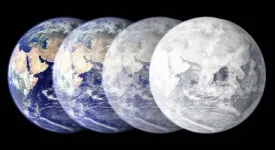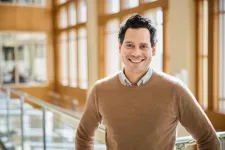(Press-News.org) From octopuses to snails, the complicated molluscan family tree has now been mapped in unprecedented detail, researchers report. This includes sequences for 13 new complete genomes from across the phylum. The genome-based phylogeny helps to resolve long-standing evolutionary debates and provides new insights into how the extraordinary diversity of species emerged from a single common ancestor. The phylum Mollusca is highly diverse with myriad morphological, ecological, and behavioral adaptions spanning both terrestrial and aquatic environments. The most well-known groups – bivalves, gastropods, and cephalopods – are accompanied by five lesser-known classes, including worm-like mollusks, chitons, and deep-sea limpets. However, while the eight living molluscan classes are unequivocally descended from a common ancestral group, efforts to determine other evolutionary relationships have been complicated. Phylogenomic analyses have gradually clarified the relationships among these groups, resolving two major clades: Conchifera (including bivalves, gastropods, cephalopods, and others) and Aculifera (comprising worm-mollusks and chitons). However, due to limited genomic resources, previous molecular studies often conflicted with morphology-based classifications and the fossil record, creating persistent uncertainties.
Here, Zeyuan Chen and colleagues present a comprehensive phylogeny of living Mollusca, constructed using genome-wide markers from 77 species encompassing all major clades and multiple representatives from each of the eight extant classes. In addition to previously published data, Chen et al. assembled 13 new genomes spanning key taxonomic groups, including two near-complete assemblies of the enigmatic deep-sea class Monoplacophora. According to the authors, the phylogeny supports a Cambrian origin for Mollusca, followed by a rapid divergence into the major clades Aculifera and Conchifera. Consistent with fossil evidence and morphological hypotheses, the poorly defined Monoplacophora was identified as the sister group to all other Conchifera. Additionally, Cephalopoda was confirmed to be the sister group to a clade comprising Gastropoda and Diasoma (which includes Scaphopoda and Bivalvia), further refining the evolutionary relationships within the phylum. “Throughout the long evolutionary history of mollusks and continuing today, aspects of a flexible genome led to a flexible phenome: Endless forms of mollusks showcase the power of animal evolution,” write the authors.
END
Genome-based phylogeny resolves complicated Molluscan family tree
Summary author: Walter Beckwith
2025-02-27
ELSE PRESS RELEASES FROM THIS DATE:
Studying locusts in virtual reality challenges models of collective behavior
2025-02-27
A study of locusts navigating in a novel virtual reality (VR) environment challenges traditional models of collective swarming behavior, researchers report. The findings show that the insects don’t just follow their neighbors like self-propelled particles but instead rely on internal cognitive decision-making processes to navigate as a collective. Collective motion, a phenomenon found widely in nature, has traditionally been described using "self-propelled particle" theoretical models from physics. These “classical” models of collective behavior, like ...
ACC, AHA issue new acute coronary syndromes guideline
2025-02-27
The American College of Cardiology and the American Heart Association today released an updated clinical practice guideline for managing individuals experiencing acute coronary syndrome (ACS). The guideline incorporates new evidence and updated recommendations to improve quality of care and outcomes. The 2025 ACC/AHA/ACEP/NAEMSP/SCAI Guideline for the Management of Patients With Acute Coronary Syndromes is published simultaneously today in JACC, the flagship journal of the American College of Cardiology, and in the American Heart Association’s flagship journal Circulation.
ACS includes a ...
Scientists match Earth’s ice age cycles with orbital shifts
2025-02-27
(Santa Barbara, Calif.) — Beginning around 2.5 million years ago, Earth entered an era marked by successive ice ages and interglacial periods, emerging from the last glaciation around 11,700 years ago. A new analysis suggests the onset of the next ice age could be expected in 10,000 years’ time.
An international team, including researchers form UC Santa Barbara, made their prediction based on a new interpretation of the small changes in Earth’s orbit of the sun, which lead to massive shifts in the planet’s climate over periods of thousands of years. The study tracks the natural cycles of the planet’s climate over a period ...
Quantum interference in molecule-surface collisions
2025-02-27
The quantum rules shaping molecular collisions are now coming into focus, offering fresh insights for chemistry and materials science.
When molecules collide with surfaces, a complex exchange of energy takes place between the molecule and the atoms composing the surface. But beneath this dizzying complexity, quantum mechanics, which celebrates its 100th anniversary this year, governs the process.
Quantum interference, in particular, plays a key role. It occurs when different pathways that a molecule can take overlap, resulting ...
Discovery of a common ‘weapon’ used by disease-causing fungi could help engineer more resilient food crops
2025-02-27
The discovery of a powerful “weapon” used by many disease-causing fungi to infect and destroy major food crop staples, such as rice and corn, could offer new strategies to bolster global food security, according to researchers from The Australian National University (ANU) in collaboration with scientists in Germany and the United States.
Like humans, many fungi rely on plants as a food source. This impacts the yield of food crops. It’s estimated farmers lose between 10 to 23 per cent of their crops to fungal disease every year.
The global research team discovered that an enzyme known as a ‘NUDIX hydrolase’ is ...
University of Oklahoma researcher to create new coding language, computing infrastructure
2025-02-27
NORMAN, OKLA. – In an increasingly data-saturated world, computing infrastructure innovations are needed to make sense of new types of information. Richard Veras, a professor in the School of Computer Science at the University of Oklahoma, has received a National Science Foundation Faculty Early Career Development Program (CAREER) award to develop such an innovation by creating more efficient infrastructure for the computation of sparse and irregular data.
Big data – datasets that are challenging to manage using traditional processing tools due to size and complexity, such as social ...
NASA’s Hubble provides bird’s-eye view of Andromeda galaxy’s ecosystem
2025-02-27
Located 2.5 million light-years away, the majestic Andromeda galaxy appears to the naked eye as a faint, spindle-shaped object roughly the angular size of the full Moon. What backyard observers don't see is a swarm of nearly three dozen small satellite galaxies circling the Andromeda galaxy, like bees around a hive.
These satellite galaxies represent a rambunctious galactic "ecosystem" that NASA's Hubble Space Telescope is studying in unprecedented detail. This ambitious Hubble Treasury Program used observations from more than a whopping 1,000 Hubble orbits. Hubble's optical stability, clarity, and efficiency ...
New ocelot chip makes strides in quantum computing
2025-02-27
Scientists based at the AWS Center for Quantum Computing on Caltech's campus have made a leap forward in figuring out how to suppress errors in quantum computers, a pesky problem that continues to be the greatest hurdle to building the machines of the future.
Quantum computers, which are based on the seemingly magical properties of the quantum realm, hold promise for use in many different fields, including medicine, materials science, cryptography, and fundamental physics. But while today's quantum computers can be useful for ...
Computing leaders propose measures to combat tech-facilitated intimate partner violence, human trafficking, and child exploitation
2025-02-27
The Association for Computing Machinery’s Technology Policy Council (TPC) has announced the publication of “TechBrief: Technology Policy Can Curb Domestic Violence, Human Trafficking, and Crimes Against Children,” a new issue brief which explains how intimate partner violence, human trafficking, and child exploitation are facilitated by computing technologies. The term “tech abuse” pertains to a wide variety of abuse in this context. The ACM policy experts contend that tech abuse is being addressed inconsistently, ...
Sometimes, when competitors collaborate, everybody wins
2025-02-27
CAMBRIDGE, MA – One large metropolis might have several different train systems, from local intercity lines to commuter trains to longer regional lines.
When designing a system of train tracks, stations, and schedules in this network, should rail operators assume each entity operates independently, seeking only to maximize its own revenue? Or that they fully cooperate all the time with a joint plan, putting their own interest aside?
In the real world, neither assumption is very realistic.
Researchers from MIT and ETH Zurich have developed a new planning ...
LAST 30 PRESS RELEASES:
New study shows how the spleen helps the immune system accept a transplant
New Mayo Clinic study advances personalized prostate cancer education with an EHR-integrated AI agent
Researchers identify novel therapeutic target to improve recovery after nerve injury
Microbes in breast milk help populate infant gut microbiomes
Reprogramming immunity to rewrite the story of Type 1 diabetes
New tool narrows the search for ideal material structures
Artificial saliva containing sugarcane protein helps protect the teeth of patients with head and neck cancer
Understanding the role of linear ubiquitination in T-tubule biogenesis
Researchers identify urban atmosphere as primary reservoir of microplastics
World’s oldest arrow poison – 60,000-year-old traces reveal early advanced hunting techniques
Bristol scientists discover early sponges were soft
New study uncovers how rice viruses manipulate plant defenses to protect insect vectors
NSF–DOE Vera C. Rubin Observatory spots record-breaking asteroid in pre-survey observations
Ribosomal engineering creates “super-probiotic” bacteria
This self-powered eye tracker harnesses energy from blinking and is as comfortable as everyday glasses
Adverse prenatal exposures linked to higher rates of mental health issues, brain changes in adolescents
Restoring mitochondria shows promise for treating chronic nerve pain
Nature study identifies a molecular switch that controls transitions between single-celled and multicellular forms
USU chemists' CRISPR discovery could lead to single diagnostic test for COVID, flu, RSV
Early hominins from Morocco reveal an African lineage near the root of Homo sapiens
Small chimps, big risks: What chimps show us about our own behavior
We finally know how the most common types of planets are created
Thirty-year risk of cardiovascular disease among healthy women according to clinical thresholds of lipoprotein(a)
Yoga for opioid withdrawal and autonomic regulation
Gene therapy ‘switch’ may offer non-addictive pain relief
Study shows your genes determine how fast your DNA mutates with age
Common brain parasite can infect your immune cells. Here's why that's probably OK
International experts connect infections and aging through cellular senescence
An AI–DFT integrated framework accelerates materials discovery and design
Twist to reshape, shift to transform: Bilayer structure enables multifunctional imaging
[Press-News.org] Genome-based phylogeny resolves complicated Molluscan family treeSummary author: Walter Beckwith





